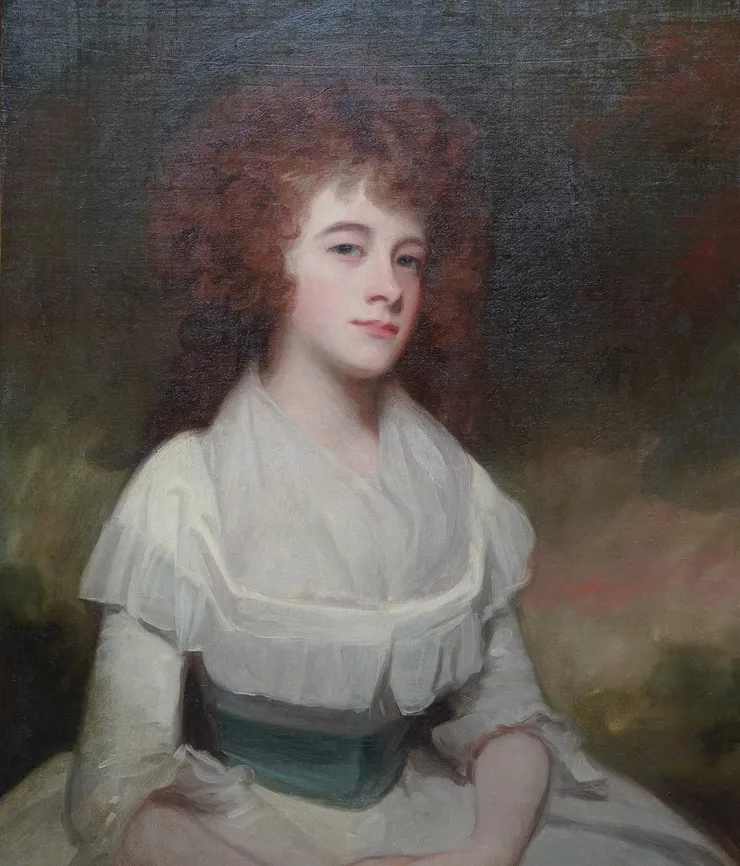George Romney (1734-1802)
| Artist Name | George Romney (1734-1802) |
|---|---|
| Title | Portrait of Anne Evelyn |
| Description | This stunning British 18th century Old Master portrait oil painting, with exceptional provenance, is by noted artist George Romney. It was painted in 1788, commissioned by James Evelyn of Felbridge as it is of his younger daughter Anne, aged 20 years old. James was a Doctor of Law and Anne's mother was his second wife, Jane. Felbridge house, Anne's home, was in the village of Godstone in Surrey. This superb oil painting is a seated portrait of Anne, wearing a white dress with a green sash, her forearms exposed and her hands in her lap. Anne is blessed with the most wonderful long auburn curly hair and is visually stunning. Her body is partly turned away from the artist/viewer and she is slightly gazing down at us with confident, clear eyes. Anne is pictured in a landscape with a dramatic sky behind her. Romney's brushwork on her dress, hair and the background is superb. The delicate detailing of her facial features is also stunning. Sometimes Old Master portraits can be a little staid, but this one of Anne with her wild auburn hair and bold look is just magnificent. This is a fantastic example of George Romney's work and of an 18th century British Old Master with exceptional detailed provenance. Name plate states: Anne, younger daughter of James Evelyn of Fellbridge Esq. 1788, aged 20. Romney. |
| Provenance | With Charles Cecil Cope Jenkinson, 3rd Earl of Liverpool (1784-1851) With The Hon. Henry Berkeley Portman (1860-1923), Later 3rd Viscount Portman; with Emma, Viscountess Portman (1862-1929) By 1926; with her daughter Lady Moyra Dawson-Damer (1897-1962) Thence by family descent. Painted in 1788. There are various labels verso. Mentioned in Lord Hawkesbury's Catalogues of Portraits at Compton Place and at Buxted Park, in Sussex, 1903, p.18, no. 3, at Buxted Park, as in the 'Dining Room, South Wall'. Further Bibliography:Gower (R. S.) Romney, London, 1904, p. 175 Kidson (Alex) George Romney, A Complete Catalogue of his Paintings, New Haven and London: Yale University Press, 2015, I, p. 205, no. 422 (illus).Ward (Humphrey) and Roberts (William) Romney: A Biographical and Critical Essay, London: T Agnew & Sons, 1904, p. 51 |
| Medium | Oil on Canvas |
| Size | 24 x 30 inches |
| Frame | Housed in an ornate gilt frame with name plate, 37 inches by 31 inches and in good condition. |
| Condition | Good condition. |
| Biography | George Romney was born in Dalton-on-Furness, Lancashire, on 15 December 1734, the third of the eleven children of John Romney and Anne Simpson. Leaving school at the age of eleven, he worked for eight years in his father's cabinetmaking workshop before being apprenticed to a local painter, Christopher Steele, with whom he served for two years, from 1755 to 1757, in Kendal, York, and Lancaster. He married a Kendal girl, Mary Abbot, on 14 October 1756, and painted at Kendal from 1756 to 1762, principally small full-length portraits. In 1762 Romney settled in London, leaving his wife and son behind, and henceforward saw them only on his few visits to the north. He won premiums for his historical paintings from the Society of Arts in 1763 and 1765, and exhibited at the Free Society between 1763 and 1769, and with the Society of Artists from 1770 to 1772. During a visit to Paris in the autumn of 1764 he was deeply impressed by the classicism of Eustache Le Sueur. His portraits were chiefly influenced by Ramsay. In 1773 he traveled to Italy with the miniaturist Ozias Humphry, remaining there until 1775, chiefly in Rome.
On his return to London Romney was patronized by the Duke of Richmond, in whose celebrated gallery of casts he had formerly studied, and took the grand house in Cavendish Square, with its large painting room, previously occupied by Francis Cotes. He achieved an instant success, and his unremitting application as a society portraitist is amply documented by his sitter books, which survive for the years 1776 to 1795. He never bothered to exhibit at the Royal Academy of Arts, though this was partly due to an antagonism with Reynolds. His health affected by overapplication, he gave up portrait painting at the end of 1795 and retired to Hampstead. In 1798 he sold the lease of his London house and returned to Kendal, where he died on 15 November 1802.
|
| Price | £90000 |

